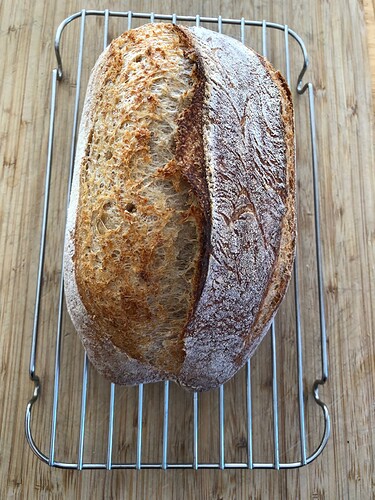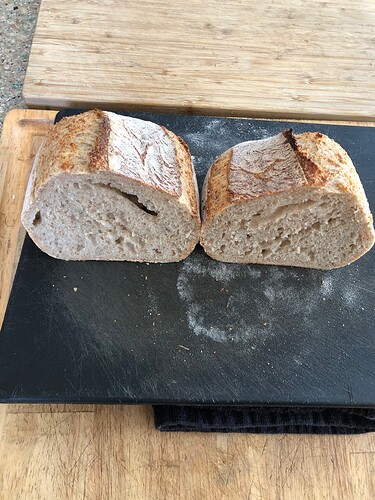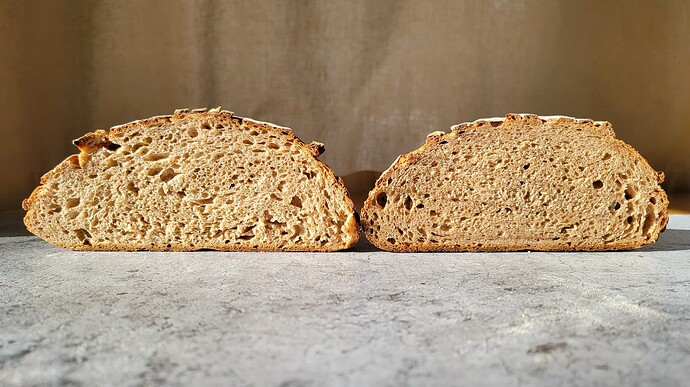Second try was much improved! I used less water initially, and that definitely helped. I tried to increase the bulk fermentation but may have let it go too long because I had to go out. It had puffed up quite a bit, so I popped it into the fridge, and then in the morning it had deflated, plus it stuck to the banneton liner. However, the crumb was much better, so I’m hoping the third times is the charm! Thanks so much for your input, Melissa.
Sounds like you made good changes. I’m sorry about the sticking, but glad the crumb was nice.
What size banneton did you use for this loaf?
I saved this recipe over a year ago, but didn’t have any whole grain rye flour. I decided to buy a grain mill for my new KitchenAid stand mixer with a 1.2HP motor and 8 quart bowl. Although I didn’t need to knead this recipe in the mixer, I did grind the rye berries. It was a cold, snowy day in Denver, so a good day to bake. I had two other loaves going with various mix and proof times. What the heck. I added one more. I will admit to being a bit unsure if I could judge the dough properly with the high hydration. So, I followed the directions exactly. At the point of forming the loaf, I decided my small, oval banneton was the best fit. I did have to heavily flour the bench, but I managed to get the loaf into the basket for the night in the frige. I will admit to 13 hours there and then into the preheated oven with the Breadtopia Cloche Baker. Although the loaf was short for the length of the baker, the width was snug. As the end of baking neared, I got out the thermometer. it read 202F. So, I gave the loaf a 5 more minute time, and another 3 minute one. It never got above 202, but the color went from light brown to rich brown. The sound was hallow, so out to the cooling rack. After 5 hours cooling, I cut it in the middle to check out the crumb. One of my best ever, but not as Swiss Cheese like as photos from others. I might increase the recipe by 50% to make a bigger loaf and fully fill the length of the cloche baker. Thanks for this terrific recipe.
Congratulations on your new KA attachment for milling. I hope you enjoyed the flavor of this bread.
I suspect the altitude of Denver is why the internal temp of the bread was below 205F and yet it was done and sounded hollow.
How do high altitudes affect cooking?
At altitudes above 3,000 feet, preparation of food may require changes in time, temperature or recipe. The reason is the lower atmospheric pressure due to a thinner blanket of air above. At sea level, the air presses on a square inch of surface with 14.7 pounds pressure; at 5,000 feet with 12.3 pounds pressure; and at 10,000 feet with only 10.2 pounds pressure — a decrease of about 1/2 pound per 1,000 feet. This decreased pressure affects food preparation in two ways:
- Water and other liquids evaporate faster and boil at lower temperatures.
- Leavening gases in breads and cakes expand more.
As atmospheric pressure decreases, water boils at lower temperatures. At sea level, water boils at 212 °F. With each 500-feet increase in elevation, the boiling point of water is lowered by just under 1 °F. At 7,500 feet, for example, water boils at about 198 °F. Because water boils at a lower temperature at higher elevations, foods that are prepared by boiling or simmering will cook at a lower temperature, and it will take longer to cook.
High altitude areas are also prone to low humidity, which can cause the moisture in foods to evaporate more quickly during cooking. Covering foods during cooking will help retain moisture.
I am very aware of the effects of the altitude on all cooking. I have gotten a Danish Rugbrod up to 205F before. Oh, well, I think my oaf was perfect. What do you think of my idea of increasing the size to 150% to fill the Cloche baker more fully?
I think increasing the loaf size by 150% might pop the lid up, but if that happens, it’s fine (I’ve done it) and that way you’ll know if it fits 
Your loaf looks lovely!
Here’s the pain de campagne recipe but with no autolyse, refrigerated starter that ripened days earlier, no active gluten development, and a same-day bake thanks to crazy summer heat.
- 300g bread flour
- 75g hard red spring wheat flour (whole grain, sprouted, freshmilled)
- 25g rye flour (whole grain, sprouted, freshmilled)
- 310g water
- 80g starter
- 8g salt
https://www.instagram.com/p/CgM0eKLM3ul/?igshid=MDJmNzVkMjY=
This week while practicing a new scoring pattern, I did a comparison of two sourdough pains de campagne with 1/2 and 1/3 bread flour. (The original recipe above is 75% bread flour.) The difference in color and openness of crumb is noticeable. Pliability of slices and depth of flavor are also a bit different.
LEFT
- 50% bread flour
- 45% turkey red wheat flour
- 5% rye flour
- 75% water
- 15% sourdough starter
- 2% salt
RIGHT
- 33% bread flour
- 59% turkey red wheat flour
- 8% rye flour
- 77% water
- 15% starter
- 2% salt
Could you recommend a substitute for Bread Flour that I could mill- like Spelt or Kamut? Or is there no substitute?
What qualities does Bread Flour have vs other flours? High protein? No bran? I do have VWG but have never used it. If high gluten is the reason for the bread flour should I add some of that?
I am still working with yeast so I was thinking about 50 min into the autolyse to bloom yeast in 40g water, allow to sit. Then mill 40g HRW into the yeast water and allow it to ‘mingle’ for the remainder of the autolyse time then incorporate as if it was a ‘ripe starter’.
I have refrigerated dough at the bulk formation (usually after 1 rise, when 2 rises + final proof are called for) for days-weeks in a marked plastic bin in the fridge with great results, I just keep them moist- then I pull it out and shape, do final proof in banneton. One time I did get ill and left for 2 weeks. In this case I cheated and added some yeast sprinkled on after the dough came to room temp and was being deflated and pre-shaped. I’m not sure this was necessary.
I just finished your article on final proof in the fridge. Will long (7+ day) refrigeration of dough not be possible when using sourdough instead of yeast?
I have not ever put a banneton in the fridge. Do you recommend the rattan or plastic type? Do you cover with a towel or plastic ‘shower cap’ type? Is there an upper limit of time you would refrigerate this way? I’m concerned the dough would dry out easier.
Do you ever spray the finished, scored dough just prior to baking to up the steam potential of a cloche?
I am used to checking a rise with the fingerprint method (no rise or sink after print - rise is complete). But how would you assess a proof from the fridge?
Thank you very much for your knowledge, articles and expertise. They are referenced so many times with appreciation!
I’m very close to beginning my starter. I just had immune ablative chemo a week ago so I am low-energy, home bound for the next 6mo at least. Maybe the starter could be my 1 project for this time. I have Breadtopia’s starter and jar. Thanks for all your guidance over the past 1+ year Melissa!
I’m so sorry you’re in for a long stretch of restricted activity. I hope that bread baking is a satisfying diversion.
Exactly as you noted, bread flour is high in protein and doesn’t have bran (or germ). You can mill spelt or kamut and sift very aggressively, but they will still be different flours. They are lower-gluten wheat berries than the hard red spring wheat of bread flour and they will have some bran and germ. This article explains more about the different milling that creates bread and all purpose flours:
Your approach to blooming yeast and pre-fermenting some of the flour sounds good. When a preferment is on the wet side, it is called called a poolish and when dryer, a biga. Here is a some interesting about the amount of poolish you might make and the timing for mixing it into the final dough:
Here is a calculator for determining how much vital wheat gluten to add to your flour. You may not know the % protein of your spelt and Kamut. Moreover, they are flours that are high in protein but not the ideal ratio of protein sub-categories for strong gluten, so they’re not ideal for these types of calculators. You may have to do trial and error. Start with 1 1/2 tsp(7 grams) VWG for 400 grams(3+ cups) flour.
Refrigerating a dough for 7 days is probably fine if you’re okay with a very sour flavor if sourdough and a somewhat sour flavor if yeast.
Either the plastic or the rattan proofing baskets will work fine in the refrigerator. I have and use both and I use these to cover the bowls:
A plastic grocery bag would work too. And yes, there is a risk of the dough drying out where it is exposed to air after mutiple days of refrigeration.
You will probably have to repeat a recipe and dough size a few times to get an idea of how much refrigerator proofing is ideal for you. The dough in the basket may look a little flatter than you’re used to because of how gas/CO2 compresses in the cold.
I sometimes brush the dough with water before baking to get a more blistered crust. I am wary of spraying, which could cause thermal shock if the baking vessel is ceramic. The vessel itself causes plenty of steam trapping for a great crust overall. The extra water is just for blisters, which don’t usually form on a whole grain bread crust anyway.
Mine turned out very flat- so I think I need to learn the poolish method and ferment the yeast longer.
I usually spray my loaves while on parchment, after scoring. Maybe this is unnecessary.
Thank you for the VWG shorthand. Do you add this in with the autolyse?
My bread eaters seem to enjoy the loaves (of the same batch) who’s dough has set longer in the fridge. I developed my own method of don’t this- mixing 4- sometimes 6- loaves worth and baking 1-3 day one and the rest later- based largely on your encouragement to use the GF technique of time.
I have been unsure of counting time in the fridge as a rise. The dough does rise but I don’t know if that ‘counts’ as a full rise called for in the recipe. I usually have my roommate get it out on his way to work at 5am and I’m getting to it around 11am to turn out and let rise for final proof from there. If the dough is still cold I do 1 rise then final proof. If room temp (about 63F year round) I preshape and place in a proofing basket.
Would you count several days in the fridge as a full rise?
The flat loaf I made with this recipe - I mean NO oven spring at all- tasted good with Spelt as bread flour, HRW and Rye as called for. There was even a bit of open crumb.
I’m doing this alongside 4 loaves of Laurel’s Country French made with a HWW called Prairie Gold from my local Mennonite Bulk Foods Store and Rye. I used yeast and ice cold water to make a very stiff dough and did a BF at 63F for 3-4 hours before dividing into 4 loaves for the fridge. The first one baked well but I thought the taste was only average.
I thought Spelt had lower protein than the hard grains but then read Spelt was 15% protein- which would put it higher than even some hard wheats. But based on this experience I agree with you my Spelt’s protein is much lower than the Prairie Gold HW I used.
So much conflicting information on web about grains.
Off to research poolish- many, many thanks for introducing me to this concept.
Test skipping the spraying one time and see how the loaf turns out.
Yes, add the VWG when you mix the flour and water.
I’m glad the method of mixing one dough and baking it in parts over multiple days is working for you. That seems both efficient and flavorful!
How much a dough rises in the refrigerator depends so many variables:
- when on the fermentation curve you put it into the cold
- what the dough temp is when it goes into the refrigerator (e.g. 65F or 85F)
- how long it stays in the refrigerator
- what temp you keep your refrigerator at
Trial and error is the best approach. If your current method isn’t over-proofing, then you probably do need that time in the a.m. from 5-11 for the dough to warm up and ferment/proof more.
As for testing several days of refrigeration, you have to look at expansion of the dough and also do the trial and error.
Wheat protein is made up of glutenin and gliadin. For a flour/grain to have strong gluten, there needs to be a high amount of protein and a particular ratio of these two subcategories.
So spelt and durum are often high total protein, but the ratios are not ideal for high gluten development. Spelt is extensible but not very elastic (it doesn’t snap back). Durum is plastic, good for shaping into pasta, but not very extensible. That is why pasta dough recipes usually involve a 30 minute rest after the heavy kneading, to let the gluten relax so the rolling isn’t as arduous.



